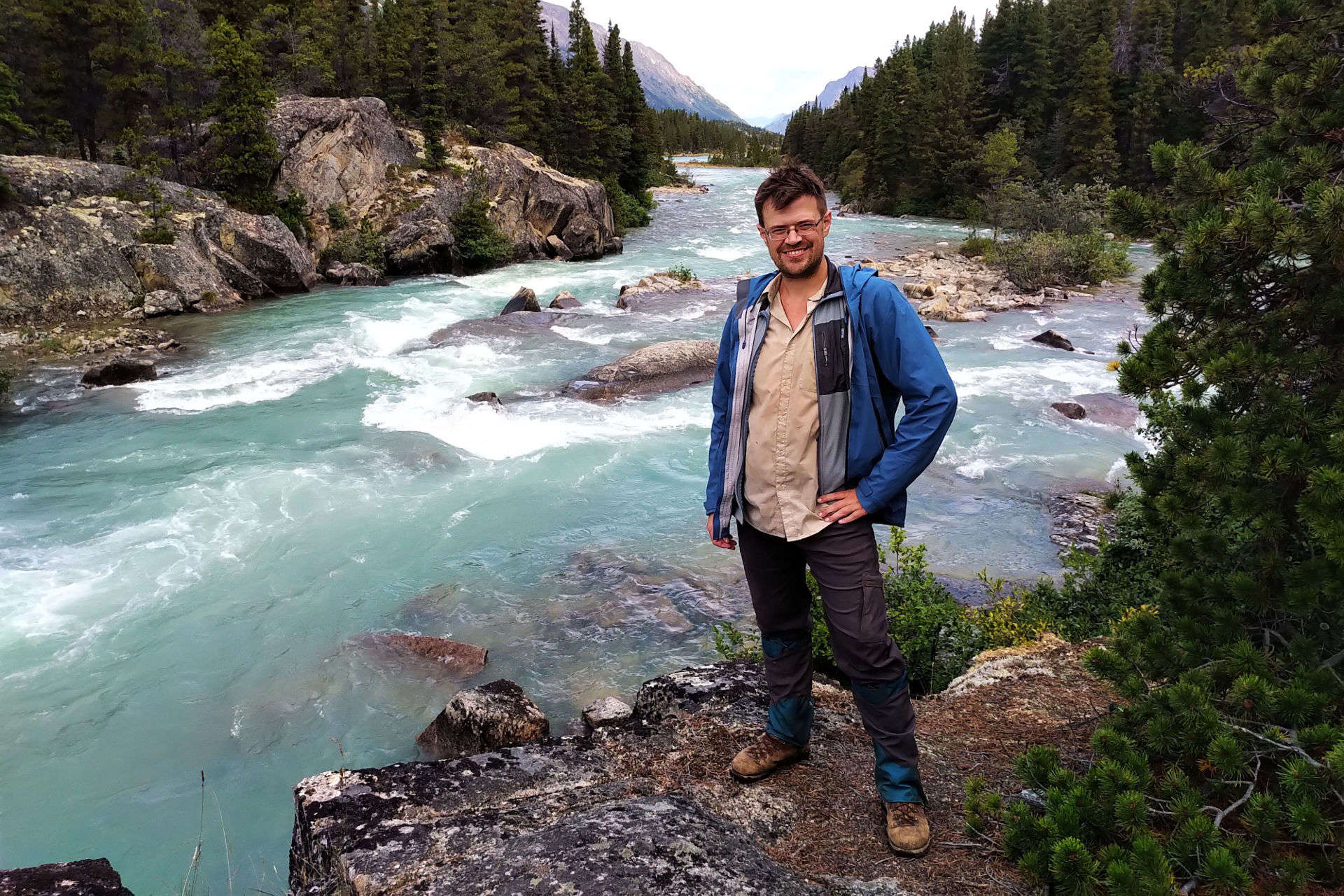Jasper National Park’s North Boundary Trail is a dream hike. From Celestine Lake to the Berg Lake trailhead in Mount Robson Provincial Park, it is much-discussed but not often-hiked. This year Thompson Valley Charters started a bus between Kamloops and Edmonton stopping at Mount Robson. I would have made it if not for Heat Dome, whose melt flooded these trails. BC Parks closed the Berg Lake Trail beyond kilometre 7 in August.
Also closed was a bridge over Twintree Creek, one of the few remaining on the North Boundary. Stuart Howe’s 2019 video shows horrible rushing blue-white water and Parks Canada has officially closed that bridge on pain of a $25,000 fine.
Berg Lake is closed for 2022 while under repair, but the North Boundary is long-neglected. Reservations are refused until September because Blue Creek bridge washed out in 2014 and they want hikers to wait until water levels go down. By all accounts Twintree Creek is tougher; it’s probably safest to consider the trail closed.
Would Jasper National Park lose a marquee trail for want of a bridge? Well, it keeps happening. The Fortress Lake trail into Hamber Provincial Park has been cut off since 2014 because of a washed-out bridge over the Athabasca River. The Athabasca Pass trail, leading to a National Historic Site of Canada, has been nigh-unreachable since the winter of 2016 due to a lost bridge at Simon Creek.
This is normally when an author bemoans Parks Canada’s budget and suggests the reader somehow vote our way out of it. Yes, Parks Canada should have the money far more than other things all politicians treat as higher priorities, but they ain’t quite broke. Earlier this year they built a 113-metre suspension bridge above Logan Creek on the West Coast Trail. A safe existing route has received a spectacular upgrade that will save hikers from what was once a morass of ladders and a shorter, still-memorable suspension bridge. The contract was valued at $840,122.
Bridges can be built, when they’re a priority.
As public expenditures go, a new Logan Creek bridge is a good one. It’s obligatory to complain that the West Coast Trail only gets easier every year but let’s face it: that thing is very popular. Trails with a lot of traffic put a lot of pressure on the environment, and infrastructure that can support ten people a day might crumble under the weight of one hundred. Parks Canada says that the ladders and the former bridge at Logan Creek, though intact, were easier to replace than constantly repair. Maybe so! No matter how many complain about the trail softening up, it’s hard to imagine anyone deliberately scrambling into and out of the Logan Creek valley just for the authenticity.
With its crushing fees1, surpassing anything else in Canada’s national parks, the West Coast Trail is also unusually capable of recovering its costs. Apart from the official entrances it’s hard to just get on the West Coast Trail and start hiking without a permit unless you are possessed of special local knowledge and plenty of patience. The mountain parks, where every long-distance trail has three or four official entrances and six that aren’t maintained but work anyway, are very different. There’s a clear cash incentive to Parks Canada for hikers to do the West Coast Trail rather than tramp about the Rocky Mountain backcountry.
But there is a point of diminishing returns, a point at which you should maybe start investing in other trails. The North Boundary could easily be very popular: it’s in the heart of Canada’s Rocky Mountain parks. If someone with a 4×4 ran a shuttle up the Celestine Lake road both trailheads would be easy to reach. It’s long, and scenic, and apart from the challenges caused by lack of maintenance, supposedly not too difficult. With apologies to those who adore the North Boundary for being so quiet, that’s a trail that could use a little popularity, if it took the pressure off of others.
Parks Canada seems not to think that way. Strategic vision for the backcountry, the sort of thinking that says “this trail at Pacific Rim National Park is overcrowded so we should try to draw visitors to this other trail in Jasper National Park,” is hard to come by. Parks are largely left to manage their own backcountry areas according to their will and their resources, and different parks have different priorities. There are so many bridges to fix it’s getting insane: the Chown Creek bridge on the North Boundary is also out, though fording may occasionally be practical.
On the one hand, it’s hard for me to imagine a better-maintained backcountry trail than the Rockwall at Kootenay National Park. On the other, while Jasper pours money into the Whistlers frontcountry campground and trails around town, not only are most backcountry trails undermaintained but volunteer labour on the remaining trails is officially discouraged. This is quite an old story. And while they may not have time to maintain distant trails, they certainly have time to harrass YouTubers about camping in the wrong parts of them2.
As anyone who’s hiked Skyline will tell you, Jasper National Park is physically capable of keeping a backcountry trail in decent shape; they just choose not to prioritize it, and they are very far from the only park that thinks this way. However, the popularity of backcountry hiking, even before COVID-19, has exploded in Canada. Canadians want to get away from their cities and spend a few nights, not even in a groomed and curated campsite with RVs and snack shops, but truly under the stars. It’s become so obvious that even BC Parks has been thrown a few crumbs.
Vain though it sometimes feels, there is a least a thin, wavering, dotted line between Canadians pointing out these problems with park policy, and the park policies being made less bad. It can be done, it has been done. Look at Logan Creek. Call attention to these flaws, shine light into darkness, and sometimes—just often enough for it to be worth doing—things improve.
January 31, 2022: this article is getting a disgracefully excessive search-engine bump for the amount of actual information in it, so I’ve added an FYI on another out bridge on the North Boundary.
March 4, 2022: this article has been updated to indicate that the Berg Lake trail will not open in 2022.
- As of 2022, hiking the West Coast Trail will cost an average of CDN$248.00 per hiker just in government fees: $69.19 for a Parks Canada Discovery Pass, $130.31 for the West Coast Trail fee, $24.50 to make the reservation, and $24.00 in mandatory ferry fees. Families, fast hikers, immigrants, and Parks Canada frequent fliers will have economies on the Discovery Pass, but the big money is non-negotiable. By comparison, a typical Rocky Mountain backcountry rate is the $69.19 Discovery Pass plus ten bucks a night for your camping.
- Incidentally, a few weeks ago I shot an e-mail to the park asking, for the sake of my vacation planning, if Jasper planned to fix the Twintree bridge in the next year. They did not have the time to reply, so maybe I’ll do a post about how great it is camping at warden cabins to get their attention.




Hi Ben,
Our publisher sent this blog post to me. What can I say? It is impossible to embarrass Parks Canada into action. A few years back Bart was in Ottawa talking with Catharine McKenna’s Chief of Staff about backcountry maintenance. His reply: “Don’t expect Parks Canada to spend one dollar on the backcountry.” Certainly emphasizes the point you make in this article.
I’m working on the 10th edition of the Canadian Rockies Trail Guide at the moment. I found your “Fire and Rain at Kootenay’s Rockwall” a useful tool in this process. (Far be it from me to actually go out to re-hike that trail for revision purposes.) But I find the current crop of masocistic backpackers a welcome source of information (I call them my “virtual friends”). It doesn’t sound like you’ve discovered my blog, but I thought you’d enjoy the following link, which features a simpler time on Kootenay Park’s Rockwall:
https://canadianrockiestrailguide.com/hiking-kootenay-park-50-years-ago/
Looking forward to your trail reports. Cheers, Brian Patton
I’m not even going to try to be cool. This makes my day.
Coincidentally, my girlfriend sent me to your blog last night, since I was telling her my new 2022 plan is to do the South Boundary Trail and your posts seem fairly essential. Thanks for sharing the Rockwall retrospective, too; that’s one trail that seems to be getting its pennies. The rest, I guess we have to hike before they’re gone.
Thanks for the shout about AND that laugh about camping at Wardens cabins!!!! Made my day. Awesome website. New fan here.
I am writing this reply while riding to Jasper to do the South Boundary, watching Evelyn and your video.
Glad you liked the post!
Hi Ben,
Four of us had reservations to hike the North Boundary Trail in September 2021. Man, was I looking forward to that hike. And then the Twintree Creek bridge got washed away (and half of the bridge over Chown Creek), our plans were aborted, and two of us hiked the South Boundary Trail instead (which was amazing, but…).
Forget about the Berg Lake Trail for a moment. Effectively, the North Boundary Trail is closed, because of a bridge (and a half). You are absolutely correct, it could be hugely popular, yet Parks Canada has decided it shouldn’t be. Where is the logic? I hiked the Rockwall Trail for the first time in the early 80’s, from the Trans Canada highway (just west of Field, B.C.) south to the Floe Lake trailhead, and saw SIX people all week. In late July. Two years ago, the Floe Lake campsite got booked solid, all 18 tent pads, for July and August, in the first 15 minutes of Parks Canada’s reservations opening. Hmm. And again you are correct, the popularity of backcountry hiking has exploded in Canada.
Once the Berg Lake Trail is re-opened in its entirety, one would hope that Parks Canada would find it in their wisdom to repair that bridge over Twintree Creek and the “half” at Chown Creek, and “re-open” the NBT. I know I’d be amongst the first to jump at the chance to hike it.
Great website. Keep it going!
Any information regarding North Boundary opening up in 2023? Thanks.
No word on the Twintree or Chown bridges being replaced yet but it looks like a “no” for this year (though apparently people have made those fords late in the season). Since the Berg Lake trail is closed past Kinney Lake it wouldn’t be a great through-trip this year anyway.
Hello Ben, I appreciated reading your thoughts.
I just stumbled on this article and thought I’d chime in with an update. I was on the North Boundary Trail in Aug 2022 and although I enjoyed that I didn’t run into another soul, I was struck by how unfortunate it was that the trail has been left inaccessible to most for lack of a couple of bridges (Chown was completely gone, as was Twintree). I’m not sure that access through Robson Park will resume this year, or even next, but when it does I really do hope Parks Canada sees the value in re-opening this beautiful route. I did see evidence of recent trail clearing (fresh chainsaw work) over Snake -Indian pass as far as Byng campsite which encouraged me that some investment was being made. I hope its an indication of a plan to move toward rejuvenating the trail.
For those interested; with Robson closed I was able to use the Great Divide Trail over Bess Pass from the Holmes River near McBride BC to access the North Boundary Trail at Chown Creek. The crossing at Chown can be forded on foot but the Twintree River definitely required the use of the packraft that I had on board. I did use this inflatable boat to paddle the entirety of the Snake-Indian River but I believe the use of a minimal version of my boat is a good answer to getting past bridges left abandoned by the park.
Hey, Dave. Thanks for the great update. The trail clearing as far as Byng is a good sign, I hope; there’d be no reason to go that far if Parks Canada wasn’t going to keep the North Boundary open someday, and I can at least understand them not worrying too much about a bridge while the trail is cut off anyway.
Dragging a packraft a hundred miles for the sake of one ford seems like a damned pain in the ass.